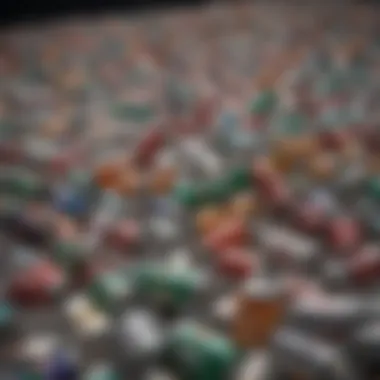Exploring the Impact of Disposable Drink Containers


Intro
Disposable drink containers play a significant role in contemporary society, appearing in many forms and materials. From plastic bottles to paper cups, these items are ubiquitous in our daily lives. Understanding their characteristics, applications, and implications is essential for students, researchers, educators, and professionals who are concerned about sustainability and environmental impacts. This article will explore various dimensions related to disposable drink containers, including their materials, environmental effects, regulations, and economic implications. Furthermore, it will provide a foundation for discussing future innovations that could lead to better practices in the industry.
Key Concepts
Definition of Primary Terms
To effectively discuss disposable drink containers, it is necessary to define some key terms:
- Disposable Drink Containers: These are containers designed for single-use, typically made from materials such as plastic, paper, or glass. They are meant to hold beverages temporarily before being discarded.
- Sustainability: This term refers to practices that meet present needs without compromising future generations' ability to meet their own needs. In the context of disposable containers, sustainability often relates to their environmental impacts.
- Circular Economy: This economic model aims to minimize waste by reusing materials and reducing single-use products. It promotes a system where materials are kept in use for as long as possible.
Related Concepts and Theories
Several concepts intersect with the examination of disposable drink containers:
- Consumer Behavior: Understanding how consumers choose and dispose of drink containers can shed light on the trends in their usage.
- Waste Management: This involves the collection, transport, and disposal of waste materials. Proper waste management practices can mitigate some of the negative effects of disposable containers.
- Environmental Legislation: National and international regulations that aim to control the impact of disposables on the environment are vital. These laws dictate how materials must be handled and recycled.
"The challenge of managing disposable drink containers is not just about individual choices but also systemic and requires coordinated action across the industry and government."
Future Directions
Gaps Identified in Current Research
Despite extensive studies on disposable drink containers, there are still areas needing further exploration:
- The effectiveness of current recycling programs.
- Long-term environmental impacts of biodegradable materials versus traditional plastics.
- Consumer awareness and its influence on sustainable practices.
Suggestions for Further Studies
Researchers should consider:
- Conducting comprehensive surveys to gauge consumer behavior towards disposable drink containers.
- Investigating technological advancements in materials that can mitigate environmental issues.
- Analyzing the economics of transitioning towards sustainable alternatives in beverage industries.
Through such analyses, a more informed understanding of disposable drink containers can emerge, leading to practical steps towards sustainability.
Preface to Disposable Drink Containers
Disposable drink containers serve a fundamental role in modern society, impacting both daily convenience and broader environmental issues. Understanding their significance requires an examination of various aspects, including material composition, recycling potential, and their contributions to consumer behavior.
As society becomes increasingly aware of environmental sustainability, disposable drink containers stand at the intersection of functionality and ecological responsibility. They are omnipresent in consumer life, found in venues ranging from fast-food restaurants to sporting events. Their widespread availability reflects consumer demand for convenience. However, this very convenience often comes at a high environmental cost, leading to increased waste and pollution.
Importance of Understanding Disposable Drink Containers
Delving into the topic of disposable drink containers is critical for several reasons:
- Sustainability Challenges: As the world grapples with the implications of plastic pollution, understanding the contribution of these containers to waste is essential.
- Regulations and Policies: Governments globally are starting to impose regulations on disposable products. Knowing these can help recycle better and reduce environmental impact.
- Consumer Education: Educating consumers about the impacts of their choices can lead to more sustainable practices in the marketplace.
Through a comprehensive exploration of the types, materials, environmental effects, and economic factors tied to disposable drink containers, this article aims to provide an informed overview. By understanding these elements, we can better navigate the ongoing dialogue surrounding waste management and sustainability.
Definition and Scope
The term "disposable drink containers" encompasses various single-use items designed for beverages such as water, soda, coffee, and juices. These containers include plastic bottles, paper cups, and aluminum cans, among others. They are primarily created for convenience, allowing consumers to easily transport and consume drinks without the need for reusable alternatives.
In terms of scope, disposable drink containers cover many industries. From beverage production to packaging and retail, their impact is felt across food service, hospitality, and consumer goods sectors. Understanding their lifecycle—from production to disposal— sheds light on both their benefits and drawbacks.
"To fully grasp the significance of disposable drink containers, one must consider not only their convenience but also the pressing environmental implications they present."
By exploring the detailed facets of these containers, this article hopes to provide clarity and motivation towards more sustainable choices.
Types of Disposable Drink Containers
The realm of disposable drink containers stands as a significant facet of our daily consumable interaction. These containers, found in various settings, serve critical roles from convenience to branding. Understanding different types is vital as it helps to navigate the complexities of environmental concerns, recycling possibilities, and consumer behaviors.


Plastic Bottles
Plastic bottles are arguably the most prevalent form of disposable drink containers. Their lightweight structure makes them easy to transport and store. Most commonly, they are made from polyethylene terephthalate (PET), which is recyclable. The significance of plastic bottles emerges not just from their convenience but also from the vast quantities produced and discarded annually. An estimated 1 million plastic bottles are purchased worldwide every minute.
Benefits of Plastic Bottles:
- Durability: They resist breakage compared to glass.
- Versatility: Suitable for a range of beverages from water to soda.
- Cost-Effectiveness: Variety available makes them affordable for many consumers.
However, environmental considerations cannot be ignored. Plastic bottles contribute significantly to pollution.
Cups and Lids
Cups and lids are essential for beverages served in casual dining, cafes, and events. They are primarily made from either plastic or paper, often lined with a waterproof coating, which complicates recycling.
Key Considerations for Cups and Lids:
- Material Choice: The option between plastic and biodegradable paper impacts waste management.
- Single-Use Culture: Convenience defines their use but also increases their environmental footprint.
Cups and lids create a unique challenge for waste management due to their mixed materials. Many consumers are unaware of the specific disposal requirements, leading to increased waste.
Aluminum Cans
Aluminum cans hold a unique position among disposable containers. They are widely used for soft drinks and beer, known for their recyclability. Approximately 75% of aluminum ever produced is still in use today due to efficient recycling processes.
Advantages of Aluminum Cans:
- Recyclability: An aluminum can can be recycled indefinitely without loss of quality.
- Preservation: They offer better protection for beverages against light and oxygen, enhancing shelf life.
The ecological footprint is less impactful compared to plastic, as recycling aluminum uses only about 5% of the energy needed to create new aluminum.
Biodegradable Options
Biodegradable drink containers have gained traction as a response to environmental crises arising from traditional plastics. These containers are designed to decompose naturally, reducing pollution. Materials commonly used include plant-based plastics and paper products, providing alternatives to conventional plastics.
Considerations Related to Biodegradable Options:
- Performance and Cost: Biodegradable containers often come at a higher cost and may not perform as well as their plastic counterparts.
- Controlled Conditions for Decomposition: They require specific conditions to break down effectively, which may not always be available outside of commercial composting facilities.
As more consumers become environmentally conscious, the demand for biodegradable options increases substantially. Understanding these distinct types of disposable drink containers helps in making informed decisions that align with environmental sustainability.
Material Composition
Understanding the material composition of disposable drink containers is crucial in any comprehensive discussion about their environmental impact and sustainability. The type of materials used influences not only the functionality and cost but also the lifecycle and ultimate disposal of the containers. These factors bear significant ramifications for ecological health as well as regulatory practices across the globe. Knowing the components of these containers allows stakeholders to evaluate both their environmental footprint and potential health risks associated with toxic additives or non-biodegradable materials.
Plastics: Types and Recycling
Plastics in disposable drink containers largely consist of polyethylene terephthalate (PET) and high-density polyethylene (HDPE). PET is often used for its clarity and strength, making it common for water bottles and soft drink containers. HDPE, recognized for its resistance to impact and chemicals, is more often seen in milk jugs and detergent bottles. Recycling these plastics presents both challenges and opportunities. While recycling technology is advancing, substantial amounts of plastics still end up in landfills or oceans due to ineffective recycling processes.
To improve recycling rates, attention to consumer education and better infrastructure is essential. Currently, only a small percentage of plastic is recycled effectively. Emphasizing the need for proper disposal methods and encouraging recycling practices can help mitigate some environmental impacts associated with these materials.
Paper vs. Plastic
The debate between paper and plastic disposable drink containers is multifaceted. Paper products, while biodegradable and made from renewable resources, often require significant water and energy for production. Additionally, many paper containers are coated with plastic or chemicals, which complicates their recyclability. Conversely, plastic containers typically have a longer lifecycle but can persist in the environment for hundreds of years, contributing to pollution and waste management challenges.
Choosing between these options requires a careful analysis of the entire lifecycle, including production energy, waste potential, and consumer behavior. As consumer preferences shift towards more sustainable options, understanding these nuances becomes increasingly important for companies looking to innovate responsibly.
Chemicals and Additives
Various chemicals and additives used in manufacturing disposable drink containers raise concerns regarding health and environmental safety. Substances such as bisphenol A (BPA) have garnered significant scrutiny due to potential health impacts. These chemicals can leach into beverages, posing risks to human health and ecosystems.
Moreover, additives used to enhance durability or appearance can also hinder recycling processes. The presence of these substances underscores the need for stricter regulations surrounding production practices and materials used in disposable containers.
Environmental Impact


The environmental impact of disposable drink containers represents a significant concern given the scale of their usage globally. These containers contribute to waste accumulation and pollution, affecting ecosystems, wildlife, and human health. Understanding the implications of these factors is essential for developing a more sustainable future. The following sections dive deeper into these critical elements.
Lifetime of Waste
Disposable drink containers have diverse lifespans based on their material composition. Plastic bottles can take hundreds of years to decompose in landfills. Similarly, aluminum cans may also persist in the environment for decades if not recycled properly. Understanding the lifetime of these products guides us toward more informed consumption choices.
Some estimates calculate the breakdown of plastic bottles can take about 450 years. This long-lasting waste leads to overflowing landfills and unsightly litter in natural environments. Reducing our consumption or improving recycling practices remains pivotal in shortening the effective lifetime of waste generated by these containers.
Pollution and Wildlife
Pollution from disposable drink containers extends beyond mere visual clutter. When improperly disposed of, they can end up in oceans and rivers, creating hazardous environments for wildlife. Turtles sometimes mistake plastic bags for jellyfish. Birds can ingest small plastic fragments, mistaking them for food. Such incidents often lead to fatal consequences.
The presence of these materials in natural habitats compromises not only wildlife but also the broader ecosystem. Studies have observed that microplastics appear in fish, which raises concerns regarding the food chain and human health. Protecting wildlife necessitates a collective shift in how society addresses the disposal and recycling of these containers.
Microplastics Concern
The issue of microplastics is increasingly alarming. Tiny plastic particles, less than five millimeters in size, emerge from the breakdown of larger plastic items, including disposable drink containers. These microplastics infiltrate soil, waterways, and even the organisms that inhabit these environments.
Research indicates that humans might consume microplastics through the food chain, raising questions about potential health impacts. There is still much to learn about the long-term effects of microplastics on human health and ecosystems. However, their presence signifies the urgency of addressing plastic pollution at multiple levels—individual consumption, waste management, and legislative interventions.
"To understand the full environmental impact of disposable drink containers, we must scrutinize their lifecycle—from production to disposal and beyond."
Addressing these concerns requires a concerted effort from governments, industries, and consumers alike. Engagement in responsible consumption practices and the promotion of sustainable alternatives can help mitigate the negative impacts associated with these ubiquitous products. Evaluating the environmental consequences serves not just as an academic endeavor but as a critical step toward change.
Regulatory Landscape
The regulatory landscape surrounding disposable drink containers is pivotal in understanding the factors that govern their production, distribution, and disposal. These regulations are designed to protect both the environment and public health, ensuring that materials used in disposable drink containers do not pose undue risks. Regulations can also influence market trends, drive innovation, and ultimately shift consumer habits. Recognizing the intricacies of these regulations allows stakeholders to navigate the compliance landscape effectively while fostering sustainable business practices.
Government Regulations
Government regulations regarding disposable drink containers vary significantly across regions. In many countries, regulatory agencies set standards for production materials, label requirements, and proper disposal methods. For example, in the United States, the Environmental Protection Agency (EPA) enforces policies that govern the use of certain plastics and their recycling processes. Similarly, the European Union has implemented directives aimed at reducing single-use plastics, such as the Single-Use Plastics Directive which bans specific items and promotes reusable alternatives.
These regulations can lead to important benefits, such as:
- Reducing environmental pollution by controlling how and when products are disposed of.
- Encouraging the development of biodegradable options and innovative packaging technologies.
- Creating economic incentives for companies that adopt sustainable practices, contributing to a circular economy.
However, there are considerations that regulators must remain mindful of. For example, overly stringent regulations might stifle innovation and increase costs for manufacturers. Striking a balance is essential.
Global Perspectives
The regulatory approach towards disposable drink containers is not uniform; it reflects local priorities and cultural attitudes towards environmental sustainability.
In countries like Denmark and Sweden, stringent regulations have led to significant reductions in the consumption of disposable products, while promoting a culture of recycling and reusability. In other regions, regulations may be less aggressive, leading to challenges in managing waste and pollution effectively.
Global frameworks, such as the United Nations Sustainable Development Goals, encourage nations to collaborate and adopt best practices in regulating disposable containers. The shared goal is to mitigate environmental impacts while supporting economic growth.
Key considerations in the global context include:
- The effectiveness of international treaties in harmonizing regulations across borders.
- The role of corporations in shaping regulatory practices through advocacy and compliance initiatives.
- Emerging technologies that may alter the regulatory landscape, such as advancements in biodegradable materials that challenge existing frameworks.
"Effective regulation can promote sustainability while ensuring that economic interests are not compromised."
In summary, the regulatory landscape is a critical factor in addressing the environmental challenges posed by disposable drink containers. By analyzing both local and global regulations, stakeholders can better understand how to adapt to future trends and make informed decisions.
Economic Implications
The topic of economic implications within the realm of disposable drink containers is critical to understanding how these products impact both the economy and the consumer. The widespread use of disposable drink containers intersects with various economic factors, such as manufacturing costs, environmental considerations, and market dynamics.
Increasing environmental awareness among consumers has led to a shifting landscape in the beverage industry, thereby creating opportunities and challenges for manufacturers and retailers alike. Companies must assess the economic benefits of shifting towards more sustainable practices while still catering to consumer demands. It also raises questions about the true costs of disposable containers versus their reusable alternatives.
Cost Analysis


The cost analysis of disposable drink containers is not merely about prices seen on the shelf but involves a meticulous consideration of several factors. Here are a few aspects to keep in mind:
- Production Costs: The manufacturing processes for materials such as plastic, aluminum, and biodegradable substances vary significantly in costs. For example, plastics are generally cheaper to produce than aluminum.
- End-of-Life Costs: After disposal, some options like traditional plastics can lead to long-term environmental costs. Municipalities face increased waste management costs, which can affect local economies.
- Recycling and Waste Management: The costs tied to recycling programs and waste management infrastructure also play a crucial role in the overall economic footprint of disposable containers. Not all materials can be recycled economically.
- Consumer Prices: Often, these cost factors will eventually translate into the prices that consumers pay. An increase in production costs might result in higher retail prices, making consumers rethink their purchasing choices.
Understanding these elements allows stakeholders to make informed decisions about the containers they choose to utilize.
Impact on Retail and Consumer Behavior
The impact of disposable drink containers on retail and consumer behavior cannot be understated. Several trends are shaping how consumers interact with these products:
- Shifts in Purchasing Preferences: Consumers are increasingly gravitating toward brands that adopt eco-friendly packaging. This shift affects sales figures and marketing strategies in notable ways.
- Brand Loyalty vs. Sustainability: Some shoppers are willing to switch brands for better environmental practices, creating a dynamic in brand loyalty. Retailers must adapt quickly to meet these changing expectations.
- Market Trends: The rise of plant-based or biodegradable containers is becoming a trend. Brands that invest in sustainable options may see a boost in their market share as consumers align their purchases with their values.
"Environmental considerations are reshaping consumer preferences, prompting retailers to rethink their supply chain strategies in favor of more sustainable practices."
Innovation and Alternatives
The examination of innovation and alternatives in disposable drink containers reveals vital points to consider in our efforts toward sustainability. As environmental concerns rise, it is clear that traditional disposable options no longer meet the expectations of a conscious consumer base. Thus, exploring emerging technologies and reusable options becomes increasingly important in addressing the challenges presented by waste management and ecological footprint.
Emerging Technologies
Innovations in materials science are leading to the development of more sustainable disposable drink containers. Researchers and corporations are investing in innovative materials that can either biodegrade quickly or reduce the chemical footprint left after disposal. Some examples include plant-based plastics and algae-infused containers. These materials can drastically lower environmental burdens by breaking down naturally, unlike traditional plastics.
The adoption of advanced manufacturing techniques also promotes efficiency and reduces waste during production. For instance, 3D printing of customized drink ware could lead to less excess material being generated. The integration of artificial intelligence into production systems ensures a more streamlined approach, minimizing waste and maximizing material usage. The transition towards these technologies is not only beneficial but necessary for a more sustainable future.
Reusable Options
Reusable drink containers present another critical alternative to single-use items. The societal shift towards reusability gains momentum through increasing public awareness of environmental impacts. Various brands, such as Hydro Flask and Klean Kanteen, offer designs that prioritize durability while encouraging consumers to adopt a habit of bringing their containers instead of relying on disposables.
Implementing incentives for consumers to use reusable products can also support this transition. Some establishments now provide discounts to patrons who bring their own cups or bottles. This approach reduces waste while resonating well with eco-conscious customers. As a result, reusable options not only lessen plastic pollution but also drive a significant change in consumer behavior, promoting a culture focused on sustainability.
Consumer Shifts Towards Sustainability
Consumer behavior is evolving significantly, particularly regarding sustainability. Today's consumers are increasingly discerning, seeking products that align with their environmental values. A notable trend is the increased demand for brands that prioritize sustainable practices. This means companies are reevaluating their production processes and materials used in their disposable drink containers.
Social media platforms, such as Facebook and Reddit, have also played a significant role in spreading awareness. The rise of online communities dedicated to sustainability is fostering greater dialogue around the importance of eco-friendly choices. Brands are influenced by these discussions and often change their strategies to meet consumer expectations.
"The willingness of consumers to shift towards sustainable options can pressure companies to innovate and provide alternatives to traditional disposable containers."
Overall, the focus on innovation and alternatives surrounding disposable drink containers highlights an urgent call to reevaluate existing practices. By examining emerging technologies, incorporating reusable options, and understanding consumer behavior, the industry can move toward more sustainable solutions that will mitigate environmental harm.
Future Trends
Understanding future trends related to disposable drink containers is vital for a comprehensive outlook on sustainability and consumer practices. This section examines the anticipated shifts in market demand, innovation, and legislation that could shape the trajectory of disposable drink containers. The implications of these trends are significant not just for manufacturers but also for consumers who are becoming increasingly conscious of environmental issues.
Emerging trends reflect how businesses adapt to growing concerns about sustainability. As more consumers seek eco-friendly alternatives, manufacturers are obligated to innovate. This may include incorporating biodegradable materials or improving recyclability of existing products. The economic feasibility of these solutions also plays a key role. Companies that fail to adapt to these changes could face challenges in maintaining market share.
New technologies are being introduced that focus on reducing waste and improving lifecycle management of products. Embracing circular economy principles is one such approach that companies are exploring. The implications of these developments extend beyond just operations; they can influence consumer behavior significantly.
Another crucial aspect to consider is regulatory changes. Governments worldwide are enacting stricter laws to address environmental issues related to plastics and waste management. Companies need to stay informed about these regulations to ensure compliance and adapt their business models accordingly. The shifting landscape could influence product design, marketing strategies, and distribution.
"The future of disposable drink containers will largely depend on innovation and consumer awareness about environmental issues."
Projected Market Changes
Projected market changes indicate a primarily evolving landscape for disposable drink containers. Recent studies suggest a dramatic shift in consumer preferences, moving towards more sustainable options. This development highlights several key elements:
- Increase in Demand for Biodegradable Products: Consumers are now showing a clear preference for biodegradable options over traditional plastics. This demand incentivizes manufacturers to invest in research and development for these products.
- Growth of Recycling Programs: Enhanced recycling initiatives could reshape how manufacturers design products. If infrastructure around recycling improves, companies can utilize recycled materials, thus lowering production costs and reducing environmental footprints.
- Technological Advancements: Innovations such as plant-based plastics and reusable packaging systems are expected to play a significant role in market changes. Such technologies may not only reduce waste but also represent a growing category of premium offerings.
- Legislation Impact: Stricter regulations will likely influence market trends. As policies banning single-use plastics become more common, businesses might need to pivot quickly or face decline.
Epilogue
The conclusion of this article underscored the multifaceted nature of disposable drink containers, a topic relevant to various sectors including environmental science, consumer behavior, and product innovation. In understanding the lifecycle of these containers and their materials, one realizes the significant role they play in both daily life and broader ecological concerns.
Summary of Key Findings
Throughout this examination, several key points emerged:
- Varied Materials: Disposable drink containers are produced from various materials such as plastics, biodegradable options, and aluminum. Each material comes with unique properties and impacts on the environment.
- Environmental Consequences: The environmental impact of these containers is severe. Many plastics persist in the ecosystem for hundreds of years, contributing to pollution and microplastic issues. Protecting wildlife and minimizing plastic waste is critical as society grapples with these challenges.
- Regulatory Framework: Government regulations vary globally, highlighting differing approaches to managing waste and encouraging recycling. Understanding these regulations is crucial for businesses and consumers alike.
- Economic Factors: The economics surrounding disposable drink containers illustrate a complex interplay between production costs, consumer habits, and sustainability. The choice of materials can greatly influence pricing and availability in the market.
- Innovation and Sustainable Alternatives: Emerging technologies are offering promising alternatives to traditional disposable containers. Reusable options are gaining traction as consumers become increasingly aware of sustainability issues.
- Future Trends: Projections indicate shifts in consumer preferences towards eco-friendly products, which may influence market offerings in the coming years.
The synthesis of these findings emphasizes the importance of addressing the sustainability challenges posed by disposable drink containers. A proactive approach that considers material selection, recycling capabilities, and consumer education is crucial for fostering an environmentally conscious society.



